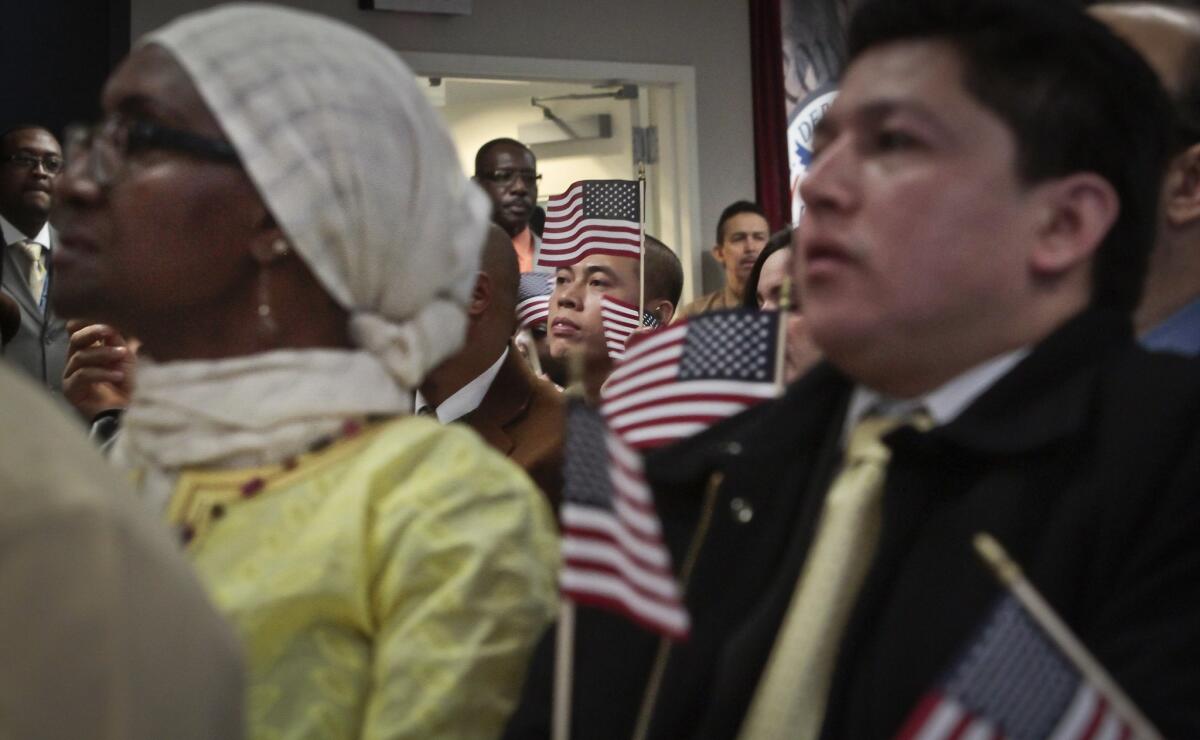Op-Ed: The law that created illegal immigration

Over the next 50 years, Asians will surge past Latinos to become the largest group of immigrants heading to the U.S., according to a new study. Above, a naturalization ceremony in New York City in 2013.
Before 1965, the United States was 85% white. Today, racial and ethnic minorities make up one-third of the population. Before 1965, the immigrant stream was largely European. Today, most new arrivals to this country come from Mexico, China and India. The passage of the 1965 Hart-Celler Immigration Act, 50 years ago this month, made these changes possible.
Contrary to what pundits often suggest, however, Hart-Celler wasn’t an unmitigated good for all ethnic groups. In fact, it set Asians and Latinos on divergent paths, with consequences that continue to reverberate today.
Starting in the late 19th century, race-based restrictions kept Asian immigration to a trickle. The 1882 Chinese Exclusion Act largely did what the name suggests; by 1924 Congress had barred all Asian groups. Eventually this complete prohibition gave way to a nominal quota system, but it wasn’t until Hart-Celler that lawmakers finally abandoned blatantly racist immigration policy.
As the standard-bearer against communism seeking to consolidate support in Vietnam, the United States had attracted international criticism of its racist policies that it could ill afford. In a nod to U.S. interests in the decolonizing world, Congress opened the gates to Asians (as well as to Africans and eastern and southern Europeans) more widely, abolishing Asian quotas and the national origins quota-system as a whole in favor of a preference system based on skills and family relationships.
For Latinos, by contrast, Hart-Celler made the U.S. less accessible. Before 1965, immigration from Mexico and other Latin American countries was largely unrestricted. It was Hart-Celler that brought Latino immigration from the Western Hemisphere under numerical limit for the first time.
A small group of lawmakers, including many longtime advocates of greater restriction, introduced the cap late in the debate as a condition for their votes. Mexico’s quota was set at 20,000 annually even though Mexicans seeking permanent residence had averaged 50,000 a year through the late 1950s.
Around the same time, Congress terminated the bracero program, a government guest worker program that, since the 1940s, had permitted millions of Mexicans to work legally in the United States. Well-publicized reports of U.S. employers abusing and exploiting braceros, as well as pressure by organized labor, led to its dissolution.
But changes on paper did not have the intended effect on the ground. As Princeton sociologist Douglas Massey has shown, Mexican migration flows that had developed over previous decades continued largely apace after 1968 (when both the Hart-Celler cap and termination took effect) as employers across the Southwest and West continued to rely on Mexican labor. The bracero program’s end and the Hart-Celler Act were, then, jointly responsible for creating the “problem” of undocumented migrants that inflames political debates today. Whole groups of migrants from Mexico and Latin America whose entrance to the U.S. would have been considered legal
before 1965 suddenly became illegal.
Despite the post-1965 divergence, Latinos and Asian Americans today find themselves in situations more similar than different. Asians make up a growing share of undocumented Americans, as the number of would-be immigrants from Asia has outstripped available visas. Consequently, deportation is not a threat facing Latinos alone. Indeed, Southeast Asians and Pacific Islanders are deported at a rate three times higher than other groups.
Politicians would do well to recognize this convergence. Instead they have sought to pit one group against the other, as in Jeb Bush’s attempted backpedaling on his use of the charged term “anchor babies” a month ago, when he suggested that Asian, not Latino, birth tourism was the real problem.
A strategy of division is a losing proposition for all. Asian Americans, Latino Americans and others have more to gain by banding together than fighting among themselves. And for candidates looking to attract votes, the numbers tell the real story. In 2013, China and India passed Mexico as the countries sending the most immigrants to the United States. A report released this week suggests that by the 2050s, Asians will surpass Latinos as the largest stream of immigrants to the United States. By then, Latino Americans will make up nearly one-quarter of U.S. residents. No one is expendable.
As they seek to address undocumented migration and related issues, today’s Congress may have reason to envy its 1965 predecessor. One pundit, writing in 2008, called Hart-Celler the “most important piece of legislation that no one’s ever heard of” because it created the diverse electorate that put Barack Obama in the White House. “No one” includes the voters of 1965, few of whom closely followed the Hart-Celler debate. In the early 1960s, immigration rarely garnered headlines, leaving political elites to debate and decide the terms of the 1965 act’s passage largely among themselves. Widespread consensus in Washington that the United States needed some kind of immigration overhaul was enough to create action. That is clearly not the case today.
Jane Hong is assistant professor of history at Occidental College. She is writing a book on the transpacific movement to repeal U.S. Asian Exclusion laws during World War II and the early Cold War.
Follow the Opinion section on Twitter @latimesopinion and Facebook
More to Read
A cure for the common opinion
Get thought-provoking perspectives with our weekly newsletter.
You may occasionally receive promotional content from the Los Angeles Times.










